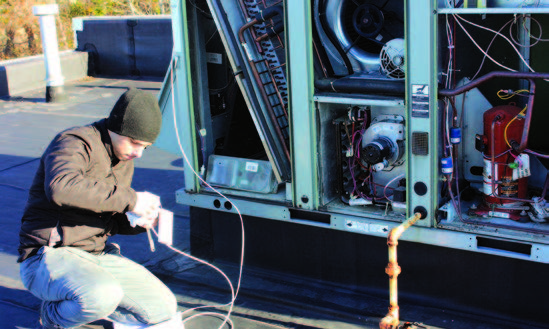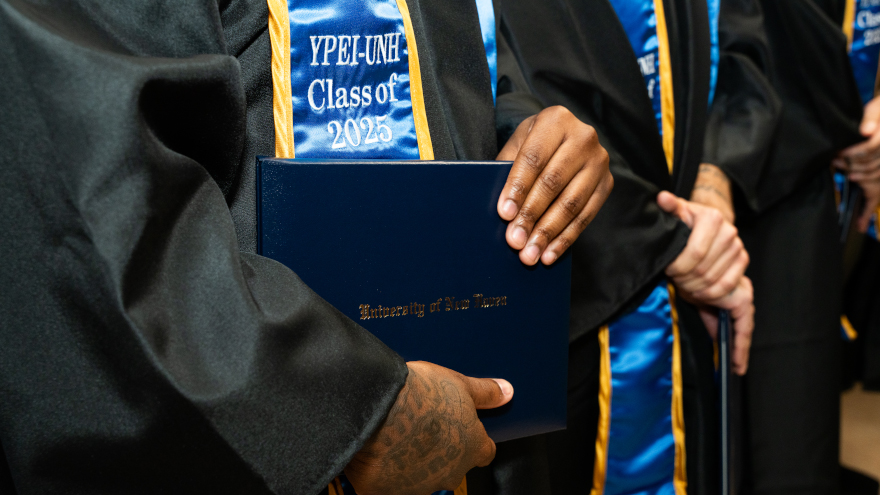Ravi Gorthala, an expert on renewable energy, has more than 20 years of industry experience and has received funding from the Department of Energy, the Department of Defense, and NASA, among other organizations.
April 5, 2018
By Jackie Hennessey, contributing writer

Dr. Ravi Gorthala, Associate Professor of Mechanical Engineering at the University of New Haven, and a team of five graduate and undergraduate students are at work on an ambitious three-year U.S. Department of Energy (DOE) project that aims to make commercial businesses’ heating, cooling, ventilation, and refrigeration systems operate efficiently.
Commercial buildings expend almost 20 percent of the nation’s energy, and experts say a large percentage of that is wasted, but Dr. Ravi Gorthala, Associate Professor of Mechanical Engineering, and a team of five graduate and undergraduate students are at work on an ambitious three-year U.S. Department of Energy (DOE) project that aims to make commercial businesses’ heating, cooling, ventilation, and refrigeration systems operate efficiently.
The $1.2 million dollar grant is funded by the U.S. Department of Energy’s Office of Energy Efficiency and Renewable Energy (EERE), with cost sharing by United Illuminating and Eversource through funds from Energize CT.
The project is titled "Bringing Fault Detection and Diagnosis (FDD) Tools into the Mainstream: Retro Commissioning and Continuous Commissioning of HVAC and Refrigeration Systems," and Jesus Amado '19, an undergraduate mechanical engineer at work on the project, explained it this way: "Think of the check engine light or tire pressure icon in a car. They light up when there may be an engine problem or the tire pressure is low; newer cars actually show the oil level."
"A rooftop air conditioning unit could be cooling a building, but the owner might not have any idea what it is costing them in terms of energy use due to faults, and some faults could be catastrophic and result in costly equipment failures. Commercially available fault detection and diagnosis (FDD) tools can be used to detect faults and let the owners or HVAC contractors know so they can look at the units, fix them, and achieve significant energy savings." Ravi Gorthala
Under this DOE project, these FDD devices and the performance monitoring systems for independent verification put together by the project team will be installed on at least 10 buildings in the state. When faults are discovered, the grant provides up to $2,000 so that the owners of the commercial buildings can fix the problems.
The team includes three graduate mechanical engineering students, Malak Souissi, a Fulbright Scholar from Morocco, Annika Hacker ’17, who is the student team project manager, Jaykishan Ramani '21, and undergraduates Jesus Amado and Amanda Rimkunas '19. They are collaborating with two subcontractors on the project — the United Technologies Research Center and the UTC Institute for Advanced Systems Engineering at the University of Connecticut.
"It is a sprawling, three-pronged project," Gorthala said, "focusing on stakeholder education, outreach, and workforce development. At work since October 2017, the students have developed project management strategies, outlined tasks and milestones, and had a kickoff meeting with UConn and UTRC at the UTC Research Center," Gorthala said.

The students are doing instrument data collection, data analysis, and research, as they explore FDD tools that exist on the market and those just coming to market. They will be surveying businesses in the state to find out why, if these products exist, they aren’t yet really commercially viable.
They’ve gathered around worktables testing dozens of sensors and constructed their own monitoring system so they can confirm the findings of the FDD tools. And they’ve been up on the rooftops of buildings working with technicians on a separate pilot FDD demonstration project funded by United Illuminating and Eversource under Energize CT to install the FDD tools and monitoring systems.
In a U.S. Department of Energy statement, David Nemtzow, director of the DOE’s Building Technologies Office, said the work aims to "improve our nation’s commercial building stock and cut energy bills for American businesses." One of five leading-edge national projects to "improve the efficiency of the nation’s commercial buildings," Nemtzow called the work "an excellent partnership among U.S. businesses, universities, and the Department of Energy."
"It even stretches us beyond engineering," Rimkunas said, noting that they are also fast becoming marketers. She was busy building the project website, and other team members are planning a major outreach event at the Energize CT Center to involve HVAC companies, the Connecticut Business and Industry Association, the Connecticut Retail Merchants Association, and the Greater New Haven Chamber of Commerce to encourage owners/managers of major corporations, supermarkets, and businesses large and small to take part in the program.
"There is a lot of planning that needs to be done, and having to plan out every detail is very intense," Hacker said. "Doing the product research is another experience. Prior to buying or ordering anything, we need to become ‘experts’ in what we are doing and what we need, which takes a lot of time, dedication, and research. It definitely gives insight on how long it actually takes to complete a project when working for a large company."
Souissi said they have become quite a team, in sync in the lab and out at work in the field. "When we face a problem, we get to brainstorm and solve it logically, then settle on a solution," he said.
"We definitely are a unique group, with different backgrounds and knowledge which allows
us to get various points of view," she said. "We are not afraid to take charge and take the initiative to learn something new." Annika Hacker ’17
Once all of the companies are on board and all the sensors and systems are in place, much of their work will focus on gathering and analyzing data. "That’s where our skills come in, doing lots of calculations to check performance," Souissi said.
Later, they will write papers and present their findings at conferences and share information with other universities who can replicate the
project and develop similar partnerships in other states. "The experience we are gaining is incredible," said Amado.
"The end result — helping owners of commercial buildings decrease energy use — is of utmost importance," Gorthala said.
A 2016 piece by Richard Gerbe in Energy Manager Today stated that commercial building operations account for 36 percent of the electricity used in the U.S. annually at a cost of $190 billion a year. He wrote, "Commercial buildings are incredibly inefficient, resulting in massive amounts of wasted energy, resources and expenditures."
Gorthala said they hope the project "will create pathways and commercialization strategies to achieve widespread U.S. adoption of this technology by bringing together all stakeholders — manufacturers, utilities, and HVAC contractors — for strategic development."
"Energy is everything. If we don’t have energy, we don’t exist," Gorthala said. "Renewable energy resources are the future and very important. But before we tap into them, the first thing we have to do is to make our existing systems energy efficient so we use less energy."




